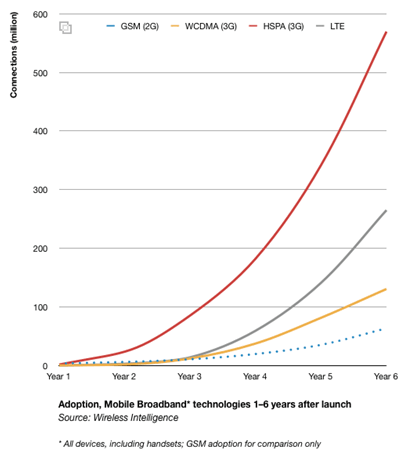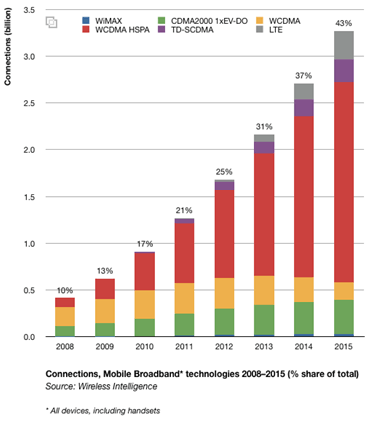The GSMA today announced that HSPA Mobile Broadband connections will reach 500 million worldwide by the end of June, making it the fastest growing wireless technology ever1. Furthermore, LTE, the next-generation Mobile Broadband technology, has now reached one million connections only a year and a half after the first commercial network launched. The announcement highlights the impact of the explosive demand for smartphones, connected tablets and Mobile Broadband dongles across the globe.
“Mobile Broadband has completely revolutionised the way we communicate. Smartphones are now essential life devices for many people and are used for everything from social networking to getting directions, listening to music and streaming content,” said Michael O’Hara, chief marketing officer at the GSMA. “In parallel, we have seen a huge rise in the number of connected devices, such as tablets and laptops, with people now relying on the ability to connect from anywhere.”
The rate of HSPA Mobile Broadband adoption in its first six years is ten times greater than the take up of 2G mobile phones when they were first introduced in the mid 1990s. Furthermore, over the next five years, mobile operators will invest almost $100 billion3 in HSPA, HSPA+ and next-generation LTE networks that offer up to 100Mbps peak download speeds, which is over ten times faster than the average wired broadband connection in the USA today4.
There are now more than 19 million HSPA connections being added each month and it is predicted that the industry will reach one billion HSPA connections by the end of 2012. LTE networks are also being rapidly introduced, with one million connections already and 300 million expected by 2015.
Joss Gillet, senior analyst at Wireless Intelligence commented: “Mobile Broadband has helped to reshape the tech landscape and bring ubiquitous Internet connections into the palm of your hand. The fast adoption of mobile Internet services has been fuelled by a rapid price erosion of devices, a demand for innovative offers and tariffs, as well as expansion of network coverage.”
“The global rollout of HSPA+ and LTE networks will play a leading role in the evolution of cloud-based applications and services. Nevertheless, device availability, regulation and pricing are key factors that will dictate growth across global regions. With regards to LTE, the Asia Pacific region will account for 43 percent of LTE connections by 2015, but growth will initially be driven by developments in North America and Western Europe,” continued Gillet.
The announcement highlights the success of HSPA, which has driven vast economies of scale across handsets, connected devices and network infrastructure. More than 3,100 devices support HSPA and there are now 350 live HSPA networks across 132 countries worldwide. Furthermore, 88 HSPA networks across 50 countries have been upgraded to HSPA+ with a further 52 network upgrades planned. HSPA+ offers peak download speeds of 84Mbps, potentially rising to 168Mbps if deployed in wider spectrum bands.
However, as user demand for Mobile Broadband continues to grow, more spectrum is needed to deliver the capacity that is required to support it. Many governments have yet to allocate the ‘digital dividend’ spectrum in the 700-800 MHz band, which will be freed up from the switchover to digital television and the 2.5-2.6 GHz band, which has been identified globally by the ITU as the ‘3G extension band’. There is also further scope for expansion through the refarming of 900 MHz and 1800 MHz spectrum, which are mainly used for 2G networks by hundreds of operators worldwide.
Below are two charts that highlight the rapid adoption of HSPA (3G) vs. GSM (2G) and other Mobile Broadband technologies:
Notes to editors
1 Wireless Intelligence 2011
2 IDC 2011
3 Operator CAPEX Summary 2011-2015 for LTE and HSPA, Rethink Technology Research
4 9.54 Mbps In-Stat February 2011
About the GSMA
The GSMA represents the interests of mobile operators worldwide. Spanning 219 countries and territories, the GSMA unites nearly 800 of the world’s mobile operators, as well as more than 200 companies in the broader mobile ecosystem, including handset makers, software companies, equipment providers, Internet companies, and media and entertainment organisations. The GSMA also produces industry-leading events such as the Mobile World Congress and Mobile Asia Congress.
For more information, please visit Mobile World Live, the online portal for the mobile communications industry, at www.mobileworldlive.com or the GSMA corporate website at http://www.gsmworld.com.
Media Contact:
Ben Evetts
[email protected] or [email protected]
+ 44 (0) 7879 614941



